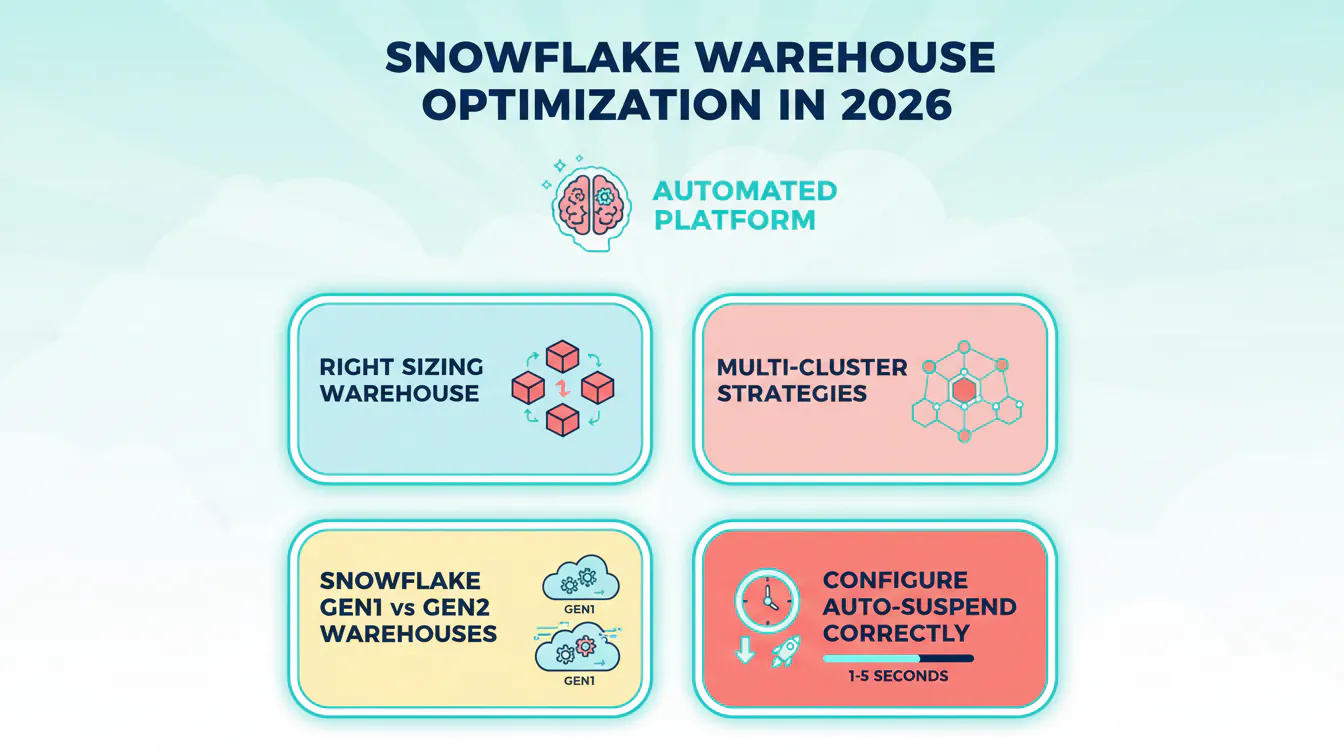What Is the Snowflake’s Storage Layer?
Snowflake’s storage layer is a central component of its architecture that manages all persisted data. It is built on top of cloud object storage services such as Amazon S3, Google Cloud Storage, or Microsoft Azure Blob Storage, depending on the cloud provider selected. This layer is fully decoupled from the compute layer, enabling independent scaling and cost optimization.
When data is loaded into Snowflake, it is automatically compressed, encrypted, and stored in a columnar format. Snowflake handles all aspects of data organization, including clustering and metadata indexing, which eliminates the need for manual tuning or partitioning by users. This allows the system to efficiently support a wide range of workloads, from small interactive queries to large batch operations.
Internally, data is divided into micro-partitions, each containing between 50 MB to 500 MB of uncompressed data. These micro-partitions are immutable and automatically maintained by Snowflake to optimize performance. Metadata about the content and statistics of each micro-partition is stored separately and used by the query optimizer to prune irrelevant data during query execution.
The storage layer ensures data durability and high availability by replicating stored data across multiple availability zones. It also supports time travel and fail-safe features, allowing users to access historical data for recovery and auditing purposes. Overall, the storage layer provides a scalable, secure, and cost-effective foundation for Snowflake’s data platform.
How Does Snowflake Charge for Storage?
Snowflake charges for storage based on the volume of data stored, calculated after compression. The storage cost is applied at a flat rate per terabyte per month, but actual pricing depends on the selected cloud provider (AWS, Azure, or Google Cloud) and region. The account type—On Demand or Capacity—also affects pricing.
There are four main types of storage usage in Snowflake:
- Database Storage: This includes all persisted data in Snowflake tables, as well as historical data retained for Time Travel and Fail-safe. Snowflake compresses all stored data, and the cost is based on the compressed size. Historical data used by Time Travel is included in the total, but Snowflake optimizes this by only retaining the minimum information needed to restore changes.
- Time Travel and Fail-safe: Time Travel allows querying previous versions of data within a configurable retention window. Storage costs for Time Travel are calculated daily, based on how much data changes. Fail-safe extends data recoverability beyond Time Travel but is intended for emergency use only and is managed by Snowflake. Costs here are based on the size of retained data copies.
- Staged File Storage: Snowflake also incurs storage charges for files temporarily staged during data load or unload operations (e.g., using COPY or Snowpipe). These costs are proportional to the file size and duration of storage. Although there’s no cost for bringing data into Snowflake (no ingress fees), compute charges apply when using operations to load data.
- Zero-Copy Cloning: Creating a clone of a database, schema, or table does not immediately incur extra storage costs because it only duplicates metadata. However, storage charges apply once changes are made to the cloned data—such as adding new records or modifying existing ones.
Snowflake Storage Pricing Examples
Snowflake’s storage pricing is tiered based on the selected cloud provider, geographic region, and whether the account is billed on an On Demand or Capacity basis. Prices are typically quoted per terabyte per month and reflect the compressed size of stored data.
Note: Pricing below is correct as of the time of this writing, and we list only the most common pricing options. For up-to-date pricing and additional options refer to the official pricing page.
On-Demand Pricing Example
For On Demand pricing, standard storage generally costs around $23 per TB/month in common regions like AWS US East (Northern Virginia), Azure East US 2 (Virginia), and GCP US East 4 (N. Virginia).
In other regions, prices can vary. For example:
- Storage in AWS AP Mumbai and Azure Japan East (Tokyo) is priced at $25 per TB/month
- GCP Middle East Central 2 (Dammam) is more expensive at $30 per TB/month.
Capacity Pricing Example
For customers on Capacity plans, pricing is reduced based on the total annual contract value (ACV). For instance, an organization with over $40 million in ACV using AWS US East can receive a rate as low as $13.80 per TB/month, compared to the default $23 rate.
Similar discounts apply across other cloud providers and regions, with deeper discounts available at higher ACV tiers.
Hybrid Tables Example
In addition to standard storage, Snowflake also offers Hybrid Tables storage, with rates around $0.34 to $0.40 per GB/month, depending on region.
For use cases requiring high-performance block storage (e.g., SPCS), block storage pricing starts at $81.92 per TB/month in AWS US East and varies by region and cloud provider.
Snowflake Storage Pricing: Summary Table
Here is a table summarizing Snowflake Storage Pricing across the three main storage types:
| Storage Type | Cloud Provider | Region | Price (USD) |
| Standard – On Demand | AWS | US East (Northern Virginia) | $23.00 |
| AWS | AP Mumbai | $25.00 | |
| Azure | East US 2 (Virginia) | $23.00 | |
| Azure | Japan East (Tokyo) | $25.00 | |
| GCP | US East 4 (N. Virginia) | $23.00 | |
| GCP | Europe West 4 (Netherlands) | $20.00 | |
| GCP | Middle East Central 2 | $30.00 | |
| Standard – Capacity | AWS | US East (Virginia), Tier 7 | $13.80 (for ACV $40M+) |
| Azure | East US 2 (Virginia), Tier 7 | $13.80 (for ACV $40M+) | |
| AWS | São Paulo, Tier 7 | $24.30 (for ACV $40M+) | |
| Azure | Switzerland North, Tier 7 | $17.28 (for ACV $40M+) | |
| GCP | Europe West 4 (Netherlands) | $20.00 (Flat – all tiers) | |
| GCP | Middle East Central 2 | $30.00 (Flat – all tiers) | |
| Hybrid Tables | AWS | US East (Northern Virginia) | $0.34 per GB/month |
| AWS | São Paulo | $0.60 per GB/month | |
| Azure | East US 2 (Virginia) | $0.34 per GB/month | |
| Azure | Switzerland North | $0.40 per GB/month | |
| GCP | US East 4 (N. Virginia) | $0.34 per GB/month |
Notes:
- Capacity pricing reflects the lowest tier (Tier 7, for ACV ≥ $40M). Lower-tier customers pay higher rates.
- Hybrid Tables are priced per GB/month rather than per TB/month.
- Prices vary by region and cloud provider, and GCP often uses flat pricing across tiers.
Strategies for Optimizing Snowflake Storage Costs
In the modern data-driven business landscape, efficiently managing cloud storage costs is paramount. Snowflake, a leader in cloud data warehousing, offers a suite of powerful features tailored for diverse data workloads. However, navigating the nuances of storage costs requires strategic insight. By understanding how Snowflake calculates storage costs, businesses can adopt effective strategies to optimize these expenses, ensuring a balance between cost efficiency and data accessibility.
Conduct Regular Audits
The first step in optimizing storage costs is conducting regular audits of your stored data. This proactive measure involves scrutinizing the data within Snowflake to identify any unused, obsolete, or redundant data that can be archived or deleted. Regular data audits help in reducing the overall storage footprint, significantly cutting down storage costs. By routinely evaluating the necessity and relevance of the data stored, businesses can ensure that only valuable and actively used data consumes storage space, eliminating unnecessary storage expenditure on outdata or irrelevant data.
Leverage Data Lifecycle Policies
Implementing data lifecycle policies is another crucial strategy for managing storage costs in Snowflake. These policies dictate how long data should be retained within Snowflake and establish guidelines for its archiving or deletion. By setting clear policies for data retention, organizations can prevent the accumulation of unnecessary data, thereby avoiding unwarranted storage costs. Data lifecycle policies ensure that data is stored efficiently throughout its useful life, from creation to eventual archiving or deletion, aligning storage practices with business needs and regulatory requirements.
Optimize Time Travel Settings
Snowflake’s Time Travel feature offers the ability to access and query historical data over a specified period, which varies depending on the Snowflake edition. While Time Travel provides significant advantages for data recovery and analysis, it also contributes to storage costs by maintaining additional copies of data. Optimizing Time Travel settings involves adjusting the retention period to retain historical data only as long as it is genuinely necessary. Reducing the Time Travel retention period can lead to substantial savings in storage costs without adversely affecting data availability for recovery and analysis purposes.
Utilize Snowflake Storage Monitors
Snowflake equips businesses with tools to monitor storage usage and costs closely. Utilizing these tools enables organizations to set up alerts and conduct regular reviews of storage reports. Storage monitors and alerts serve as an early warning system, notifying businesses when storage usage approaches predefined thresholds. This allows for timely interventions to manage storage consumption effectively and stay within budgetary limits. Regularly reviewing storage reports provides insights into storage trends and usage patterns, enabling businesses to identify opportunities for optimization and make informed decisions about storage management.
Cost-Effectively Leveraging the Power of Snowflake
Optimizing storage costs is integral to managing a cost-efficient and effective data warehousing strategy. By implementing regular data audits, leveraging data lifecycle policies, optimizing Time Travel settings, and utilizing Snowflake storage monitors, businesses can achieve significant savings in storage costs. These strategies not only contribute to a more economical use of Snowflake’s storage capabilities but also encourage a disciplined approach to data management. In doing so, organizations can harness the full potential of their data, driving insights and value while maintaining control over their storage expenditures. As businesses continue to navigate the complexities of big data, adopting these strategic practices will be key to maximizing the benefits of Snowflake’s powerful cloud data warehousing solution.







